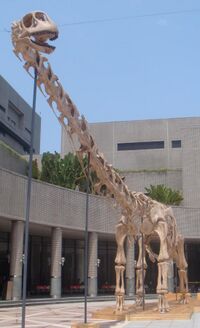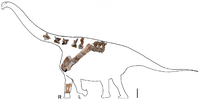Earth:Hekou Group
From HandWiki
| Hekou Group Stratigraphic range: Early Cretaceous,[1] Valanginian–Albian | |
|---|---|
| Type | Geologic group |
| Sub-units | Huazhuang Formation, Hongkoucheng Formation, Yanguoxia Formation, Zhujiatai Formation |
| Underlies | Unconformity: Minhe Formation |
| Overlies | Unconformity: Xiangtang Formation |
| Thickness | 3,700 m (12,100 ft) |
| Lithology | |
| Primary | Sandstone, mudstone, conglomerate |
| Location | |
| Coordinates | [ ⚑ ] : 35°54′N 103°18′E / 35.9°N 103.3°E |
| Paleocoordinates | [ ⚑ ] 34°48′N 103°06′E / 34.8°N 103.1°E |
| Region | Gansu |
| Country | |
| Extent | Longzhong Basin |
| Lua error in Module:Location_map/multi at line 27: Unable to find the specified location map definition: "Module:Location map/data/Gansu" does not exist. | |
The Hekou Group is a geological group in Gansu Province, China . It is Early Cretaceous in age. Many dinosaur fossils have been recovered from the Hekou Group, including iguanodonts, large sauropods, and armored dinosaurs. Fossil eggs are rare, but one oogenus, Polyclonoolithus, was discovered in the Hekou Group.[2] Extensive fossil tracks belonging to pterosaurs and dinosaurs have also been described.[3][4] The group spans the Valanginian to Albian and can be subdivided into four formations.[1]
Vertebrate paleofauna
Dinosaurs
Saurischians
| Genus | Species | Region | Material | Notes | Images |
|---|---|---|---|---|---|
| Daxiatitan | D. binglingi | Upper; Lanzhou-Minhe Basin[5] | A partial skeleton including cervical, dorsal, and caudal vertebrae, ribs, and a haemal arch, scapulocoracoid, and femur | A large titanosauriform sauropod | |
| Huanghetitan | H. liujiaxiaensis | Upper; Lanzhou-Minhe Basin[5] | A partial skeleton including caudal vertebrae, a partial sacrum and ribs, and the left shoulder girdle | A large titanosauriform sauropod | |
| Yongjinglong[5] | Y. datangi | Upper; Lanzhou-Minhe Basin | A partial skeleton including teeth, cervical and dorsal vertebrae, a rib, the left scapulocoracoid, and the right ulna and radius | A euhelopodid titanosauriform sauropod[6] |
Ornithischians
| Genus | Species | Region | Material | Notes | Images |
|---|---|---|---|---|---|
| Lanzhousaurus[7] | L. magnidens | A partial skeleton including the mandible, maxillary teeth, dentary teeth, cervical and dorsal vertebrae, sternal plates, ribs, and pubes | A large styracosternan iguanodontian | ||
| Stegosaurus[8] | S. sp. | Upper member; Lanzhou-Minhe Basin | A partial skeleton including cervical and dorsal vertebrae, ribs, a right forelimb (including a partial humerus, ulna, and radius), and one dermal plate | A stegosaur distinct from Wuerhosaurus and Stegosaurus stenops. Likely contemporary with Taohelong. | |
| Taohelong[9] | T. jinchengensis | Upper member; Lanzhou-Minhe Basin | A partial skeleton including ribs, a left ilium, a caudal vertebra, and part of the sacral shield | A nodosaurid ankylosaur, originally described as the first Asian member of the Polacanthinae |
Fish
| Genus | Species | Region | Material | Notes | Images |
|---|---|---|---|---|---|
| Sinamia[10] | S. lanshoensis | Middle–Lower subgroup; "fish quarry" | Many well-preserved specimens as part and counterpart fossils | A sinamiid amiiform fish |
References
- ↑ 1.0 1.1 Xi, D.; Wan, X.; Li, G.; Li, G. (2018). "Cretaceous integrative stratigraphy and timescale of China". Science China Earth Sciences 61: 1–31. doi:10.1007/s11430-017-9262-y.
- ↑ Xie, J.-F., Zhang, S.-K., Jin, X.-S., Li, D.-Q., and Zhou, L.-Q. (2016) "A new type of dinosaur eggs from Early Cretaceous of Gansu Province, China. " Vertebrata PalAsiatica, 54(1):1-10.
- ↑ Lockley, M.; Harris, J.D.; and Mitchell, L. 2008. "A global overview of pterosaur ichnology: tracksite distribution in space and time." Zitteliana. B28. p. 187-198. ISSN 1612-4138.
- ↑ Li, Dawing; Azuma, Yoichi; Fujita, Masato; Lee, Yuong-Nam; Arakawa, Yohei (2006). "A preliminary report on two new vertebrae track sites including dinosaurs from the Early Cretaceous Hekou Group, Gansu Province, china". Journal of the Paleontological Society of Korea 22 (1): 29–49. https://citeseerx.ist.psu.edu/document?repid=rep1&type=pdf&doi=232130b517148a0d21f2d28356d1f560b19fc9a8.
- ↑ 5.0 5.1 5.2 Li, L. G.; Li, D. Q.; You, H. L.; Dodson, P. (2014). Butler, Richard J. ed. "A New Titanosaurian Sauropod from the Hekou Group (Lower Cretaceous) of the Lanzhou-Minhe Basin, Gansu Province, China". PLOS ONE 9 (1): e85979. doi:10.1371/journal.pone.0085979. PMID 24489684.
- ↑ Mannion, P.D.; Upchurch, P.; Jin, X.; Zheng, W. (2019). "New information on the Cretaceous sauropod dinosaurs of Zhejiang Province, China: impact on Laurasian titanosauriform phylogeny and biogeography". Royal Society Open Science 6 (8): 191057. doi:10.1098/rsos.191057. PMID 31598266.
- ↑ You, Hailu; Ji, Qiang; Li, Daqing (2005). "Lanzhousaurus magnidens gen. et sp. nov. from Gansu Province, China: the largest-toothed herbivorous dinosaur in the world" (in en). Geological Bulletin of China 24 (9): 785–794. ISSN 1671-2552. https://www.researchgate.net/publication/294696068_Lanzhousaurus_magnidens_gen_et_sp_nov_from_Gansu_Province_China_The_largest-toothed_herbivorous_dinosaur_in_the_world.
- ↑ Li, Ning; Li, Daqing; Peng, Guangzhao; You, Hailu (2024). "The first stegosaurian dinosaur from Gansu Province, China" (in en). Cretaceous Research (in press): 105852. doi:10.1016/j.cretres.2024.105852. https://linkinghub.elsevier.com/retrieve/pii/S0195667124000259.
- ↑ Yang J.-T.; You H.-L.; Li D.-Q.; Kong D.-L. (2013). "First discovery of polacanthine ankylosaur dinosaur in Asia" (in Chinese, English). Vertebrata PalAsiatica 51 (4): 265–277. http://www.ivpp.cas.cn/cbw/gjzdwxb/xbwzxz/201312/P020131205318740255664.pdf.
- ↑ Peng, Cuo; Murray, Alison M.; Brinkman, Donald B.; Zhang, Jiang-Yong; You, Hai-Lu (2015-03-04). "A new species of Sinamia (Amiiformes, Sinamiidae) from the Early Cretaceous of Lanzhou Basin, Gansu, China" (in en). Journal of Vertebrate Paleontology 35 (2): e902847. doi:10.1080/02724634.2014.902847. ISSN 0272-4634.
See also
- List of fossil sites
- List of dinosaur bearing rock formations
 |





